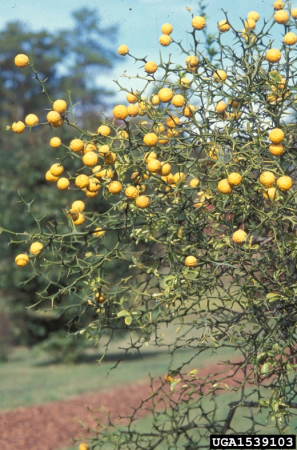Trifoliate Orange

DESCRIPTION
The common name Trifoliate Orange is in reference to the three-lobed leaves and orange fruit. This shrub grows 8-15 feet tall. The white flowers have 4-7 petals and are fragrant and showy, and the stems are covered heavily with sharp thorns. The leaves emerge as yellowish green, turn dark green by summer, and fall off the tree in autumn. The fruit is edible, but they are very acidic, sour, and seedy. They ripen to a bright yellow and are usually 1-2.5 inches in diameter.
ECOLOGICAL THREAT
This hardy and thorn-laden shrub is able to invade woodlands, forest edges, and disturbed urban areas such as fence rows and green spaces. They grow in the understory very rapidly and can shade out native plants. Their vicious thorns do not provide adequate habitat or shelter for nesting birds, squirrels, or burrowing animals.
BIOLOGY
Flowers bloom from April to May, fully covering the branches. Fuzzy green fruit appears from July to October and contains multiple seeds within They ripen to a bright yellow. Animals help disperse the seeds.
HISTORY
In the 1850s, it was introduced from China and Korea, possibly as a thorny hedge to confine livestock. It has been fully established throughout Louisiana and is prominent in Arkansas.
NATIVE ORIGIN
Central and northern China
CURRENT LOCATION
U.S. Habitat: Ideal in full sun exposure in soils with medium moisture. It is not cold tolerant.
U.S. Present: AL, AR, DE, FL, GA, LA, MD, MO, MS, NC, OK, PA, SC, TN, TX, VA, and WV.
For a state and county distribution map provided by the PLANTS database, click here.
RESEMBLES
Initially placed in the Citrus genus, its fruit closely resembles those Citrus species. The thorns and fruit can also resemble the Osage-Orange, Maclura pomifera.
MANAGEMENT
Mechanical management can prove to be quite difficult with the plant being covered in thorns. However, it responds well to bulldozing when the fruits are absent. If you find new plants, pull them or treat them chemically before fruits can be formed. The hardy orange does respond to chemical treatments with glyphosate, triclopyr, or a combination of the two. The herbicides work better after the plant has been freshly cut and the chemicals are directly applied to it.
Internet Sources
http://plants.usda.gov/core/profile?symbol=POTR4
http://www.invasiveplantatlas.org/subject.html?sub=11571
http://www.uaex.edu/yard-garden/resource-library/plant-week/hardy-orange-2-9-07.aspx
http://www.invasive.org/publications/ipsf/TrifoliateOrange.pdf
http://wiki.bugwood.org/Archive:MGIPSF/Trifoliate,_Hardy_Orange
